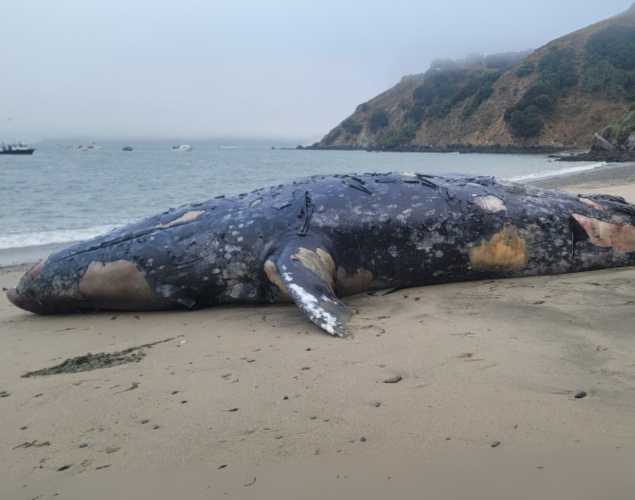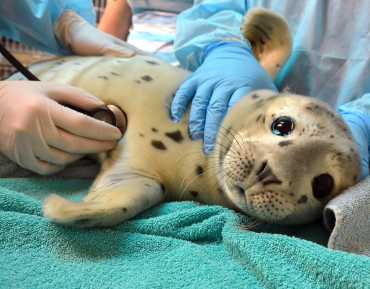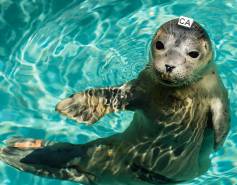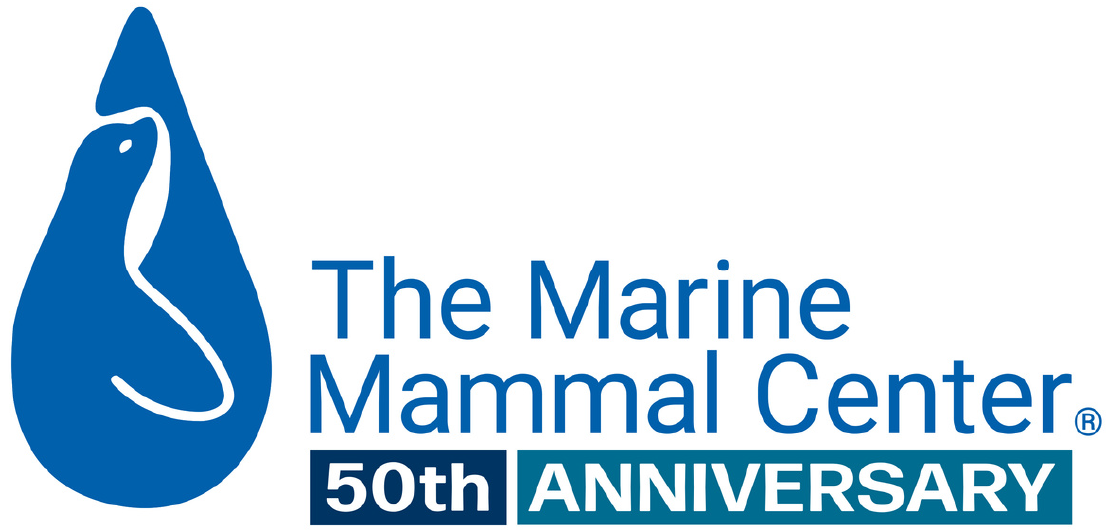
Scientists respond to dead gray whale in San Francisco Bay as species faces population recovery challenges
Scientists respond to dead gray whale in San Francisco Bay as species faces population recovery challenges
The dead whale response marks the 21 dead gray whale in the Bay Area this year, the most since 2000
(SAUSALITO, Calif. – July 17, 2025) Scientists at The Marine Mammal Center and partners at the California Academy of Sciences can confirm a dead gray whale that washed up in Richmond died as a result of blunt force trauma due to a suspected vessel strike. The news comes as partners at the National Oceanic and Atmospheric Administration (NOAA) released a revised population estimate showing continued decline in eastern north Pacific gray whale numbers, some 13,000 individuals, the lowest since the 1970’s.
The Center first received reports of a dead whale floating underneath the Richmond Long Wharf adjacent to the Richmond-San Rafael Bridge on Monday afternoon, July 7. A responder from the Center confirmed the presence of the subadult female gray whale in good body condition. On Thursday, July 10, the whale was successfully towed to Angel Island State Park by a private towing service for a necropsy or animal autopsy.
In a necropsy, or animal autopsy, conducted Friday morning, July 11, a team of 10 scientists identified the whale as a 37-foot whale in average body condition based on the fat stores and blubber layer. The main finding was hemorrhaging on the animal’s left lateral side between the head and pectoral fin, concentrated near the skull, consistent with blunt force trauma due to a suspected vessel strike. In addition, experts at the Center collected stomach contents for further analysis.
“This latest gray whale caught everyone a bit by surprise given how late in the season it is and the fact that we had not sighted the species in the bay in nearly two weeks,” says Kathi George, Director of Cetacean Conservation Biology at The Marine Mammal Center. “With the bay and our immediate coast serving as a shared space for commerce and increasing whale activity, including humpback whales, it’s vital that all boaters, from large commercial vessels to sailboats, be whale aware. If you see a blow, go slow.”
The recent population assessment news from NOAA shows gray whales are a sentinel species known for their behavioral adaptability struggling to recover from the recent 2019-2023 Unusual Mortality Event (UME) due to impacts of food resource availability shifts in the arctic because of climate change. In addition, NOAA reports in a recent web story a concerning statistic that “only about 85 gray whale calves migrated past Central California on their way to feeding grounds in the Arctic earlier this year.”
That figure according to NOAA is the lowest number since records began in 1994 and the continued low calf numbers since the start of the UME in 2019 indicates that reproduction rates have remained too low for the population to rebound.
The Center’s Cetacean Conservation Biology Team has reported an unusually high number of sightings in the San Francisco Bay this year, with more than 35 individual gray whales confirmed via photo identification. By comparison, only six gray whales were sighted in the bay in 2024.
“While San Francisco Bay serves as a small puzzle piece in their lengthy annual migration, research documenting individual animals via photo ID, shifts in foraging behavior, length of stay, and necropsy findings, are vital to paint a bigger picture on how this species is adjusting to a rapidly changing environment,” says George. “Gray whales do not recognize international borders and so the need for continued funding and sharing of collected data is vital to document what is happening to them in real time and to develop effective solutions to help address the situation.”
Historical stranding data, of the Center’s and the Academy’s whale responses from this year across our 600-mile California response range, can be found here.
For more information or to set up an interview on this topic, please contact us at media@tmmc.org.
For breaking news about our whale responses as well as additional press materials, bookmark MarineMammalCenter.org/whale-stranding.
Yes, I want to save a life!

Yes, I want to save a life!
You’ll be giving sick and injured animals the best possible care at the Center’s state-of-the-art hospital. With your gift today, you are giving a patient a second chance at life in the wild.
See Our Latest News
{"image":"\/Animals\/Patients\/Harbor seals\/2020\/cropped-images\/hs-barnwood-by-bill-hunnewell-c-the-marine-mammal-center-315-0-3299-2577-1607370547.jpg","alt":"harbor seal Barnwood","title":"Last-Minute Gift Guide \u2013 Top Gifts that Give Back to Marine Animals","link_url":"https:\/\/www.marinemammalcenter.org\/news\/last-minute-gift-guide","label":"News Update","date":"2025-12-18 01:00:00"}

Last-Minute Gift Guide – Top Gifts that Give Back to Marine Animals
December 18, 2025
Read More{"image":"\/Animals\/Patients\/Hawaiian monk seals\/2025\/cropped-images\/b-ru72admission-to-ke-kai-ola112125photo-c-the-marine-mammal-center-noaa-permit-24359-0-364-1270-992-1766095407.jpg","alt":"A newborn Hawaiian monk seal pup with a black coat in rehabilitative care.","title":"Newborn Hawaiian Monk Seal Pup Now Receiving Care","link_url":"https:\/\/www.marinemammalcenter.org\/news\/newborn-hawaiian-monk-seal-pup-now-receiving-care","label":"Patient Update","date":"2025-12-18 01:00:00"}

{"image":"\/Animals\/Patients\/Hawaiian monk seals\/2025\/cropped-images\/d-ru28release-exam-at-ke-kai-ola111025photo-by-giancarlo-rulli-c-the-marine-mammal-center-noaa-permit-24359-0-0-1270-992-1764620886.jpg","alt":"","title":"Bird Flu Vaccine Trial Offers Hope for Protecting Hawaiian Monk Seals","link_url":"https:\/\/www.marinemammalcenter.org\/news\/bird-flu-vaccine-trial-may-offer-hope-for-protecting-hawaiian-monk-seals","label":"News Update","date":"2025-12-01 08:13:00"}

Bird Flu Vaccine Trial Offers Hope for Protecting Hawaiian Monk Seals
December 1, 2025
Read More{"image":"\/Animals\/Patients\/Hawaiian monk seals\/2021\/hms-pp08-by-sheila-latta-c-the-marine-mammal-center-noaa-permit-18786.jpg","alt":"Hawaiian monk seal","title":"The New York Times: Inside the Bird-Flu Vaccine Trial for Monk Seals","link_url":"https:\/\/www.marinemammalcenter.org\/news\/the-new-york-times-inside-the-bird-flu-vaccine-trial-for-monk-seals","label":"In the News","date":"2025-12-01 01:00:00"}

The New York Times: Inside the Bird-Flu Vaccine Trial for Monk Seals
December 1, 2025
Read More


